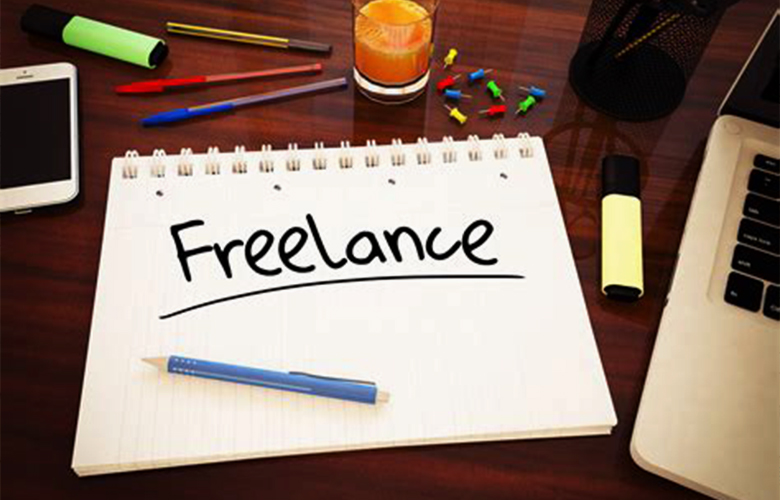
In May 2021, I left my radio job of four years to start freelancing full-time. I’d been editing podcasts for a couple of different clients for the past month or two, but now I was starting to pick up more work, and it felt like the right time to make the leap.
Unlike a lot of people, I was fortunate to remain in employment throughout the pandemic. I’d been working from home for over a year (an interesting experience when your job is in live radio). But I was ready to move on, for a combination of reasons. So when new opportunities presented themselves, I couldn’t say no.
I won’t lie: I was terrified. As someone who suffers from anxiety (more on that in a future blog post), I was plagued by that voice in my head telling me I was crazy to go freelance. What if the work dried up? What if I wouldn’t make enough money? And in the middle of a pandemic! What was I thinking?
My fears weren’t entirely unjustified. I did have a few quiet weeks early on. But as I soon learned, things can change very quickly, and before you know it you’re juggling two or three different projects at once. Seven months in, I still have times when I’m not very busy. But this isn’t always a bad thing, especially coming off the back of a particularly hectic period where you feel you’ve barely had time to breathe. It helps you take a moment to refresh and refocus.
It’s true that this is a risk you take, but if you’re able to build a strong client base, it really helps. Don’t underestimate the power of a good recommendation. If you do a great job for someone, chances are they’ll work with you again (or even give you a regular gig) and will be only too happy to let someone else know about you, which in turn leads to more work.
Despite my worries about the negative side of freelancing, I’ve also found that there are a lot of positives. I really enjoy having the freedom to choose my own hours. Some people might struggle with structuring their day and resisting the temptation to procrastinate, but luckily I’ve always been pretty good at motivating myself to sit down and get things done. I will freely admit that I am not a morning person. That’s not to say I can’t or won’t get up early for work (I used to have a 5 am start on Sundays) but I certainly don’t enjoy it. So I don’t worry too much about the 9-5 thing unless a project specifically requires it. As long as I’m getting the job done to the best of my ability and communicating clearly with my clients at all times, that’s the most important thing.
The freedom to choose not only which hours you work, but which projects you work on, is another positive. But there are also challenges. I’ve had to think long and hard about my boundaries this year. When you’re just starting out in the freelance world and trying to build your client base, it can be very tempting to accept everything that comes your way. Maybe the money is really good, or it’s a chance to gain experience in a new area that will look great on your CV. But what if you’re already juggling a lot of projects and barely have any free time? You might be afraid to turn down work in case that client doesn’t offer you anything else in the future, or you might just be keen to make a good impression and show them what you can do. But sometimes it is good to say no. If you take on too much, you will simply be incapable of giving your best to each project. The work itself will suffer, and so will your mental health. We’ve all experienced burn-out, and we should try to avoid it wherever possible. Only say yes if you think you can realistically manage it.
Setting boundaries is also important when it comes to dealing with existing clients. I’ve been very lucky to work with a lot of brilliant people, but occasionally you do come across someone who thinks nothing of asking you to edit an hour’s worth of audio at a minute’s notice, or sending you WhatsApp messages about work at three in the morning and expecting you to respond. Thankfully a rare occurrence, but it does happen. Many people feel unable to switch off from work even when they’re not freelancers. They might stay late at the office or answer phone calls and emails after going home for the day. But when you’re freelance, these issues are often magnified. There are people who expect you to always be available, at all hours of the day and night, and who want everything yesterday. And there are others who set unrealistic expectations, such as consistently giving you badly recorded audio which you simply cannot fix. Being open about your boundaries and the ways you will and won’t work is important. That way, clients know exactly what they can expect from you, and what you expect from them. If they’re not willing to respect those boundaries, you can walk away and save yourself a lot of stress. If they are willing, you’ll have a healthy and harmonious working relationship.
In hindsight, I think the decision to go freelance during a pandemic was more of a blessing than a curse.
This whole situation has forced businesses to consider remote working, and so many more people have also started podcasts in the last two years, which means more work for freelancers in the industry. I’ve been working with clients from around the world from the comfort of my own home, which I never would have dreamed of pre-pandemic. And it’s not just podcast editing; I’ve also recorded and sound-designed audio drama, made radio promos, and even appeared on shows myself as a contributor.
I’d only been doing this for about a week when people started asking me when I was planning to return to a “stable” job. It occurred to me that many people outside the industry still don’t really understand freelancing and just how common it actually is. Then again, I also used to get asked how much longer I was going to do “this radio thing” before having to get a “proper” job. So I guess being employed by a radio station is now considered stable after all!
I don’t know what the future holds; none of us do. But for now, I’m enjoying the diverse range of projects I get to work on and the freedom to pursue what interests me.
Getting Your Head In The Game – The Pre Show Routine
Tips and Tricks for Subs and Replacements


The mission of SoundGirls.org is to inspire and empower the next generation of women in audio. Our mission is to create a supportive community for women in audio and music production, providing the tools, knowledge, and support to further their careers. SoundGirls.Org was formed in 2013 by veteran live sound engineers Karrie Keyes and Michelle Sabolchick Pettinato and operates under the Fiscal Sponsorship of The California Women’s Music Festival, a 501(c)3 non-profit organization. In 2012, Karrie and Michelle participated in the “Women of Professional Concert Sound” panel at the AES Conference in San Francisco. The panel was hosted by the Women’s Audio Mission (WAM) and moderated by WAM founder Terri Winston. Terri brought together five women working in live and broadcast audio. The groundbreaking panel (which also included Jeri Palumbo, Claudia Engelhart and Deanne Franklin), provided young women and men a glimpse into life on the road, tips and advice, and a Q & A with the panelists. More importantly though, was how incredibly powerful the experience was for the panelists. We had all been in the business for 20 years or more, yet most of us had never met before that day and within minutes we bonded like long-lost sisters. We were struck by how similar our experiences, work ethics, and passions were and wondered why our paths had never crossed and how our careers would have been different had we been there to support each other through the years. Each of us are strong on our own, but together we were even stronger and a powerful force. We were empowered. Each of us had been asked hundreds of times in our careers: Are there other women doing sound? How did you get into sound? How would a young woman go about getting into sound? Through creating SoundGirls.Org, we hope to establish a place for women working in professional audio to come for support and advice, to share our success and failures, our joys and frustrations, and for empowerment and inspiration.
Read Full Profile© 2021 TheatreArtLife. All rights reserved.

Thank you so much for reading, but you have now reached your free article limit for this month.
Our contributors are currently writing more articles for you to enjoy.
To keep reading, all you have to do is become a subscriber and then you can read unlimited articles anytime.
Your investment will help us continue to ignite connections across the globe in live entertainment and build this community for industry professionals.